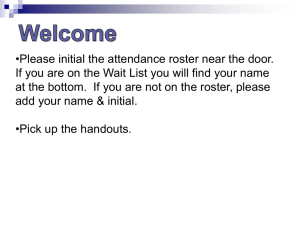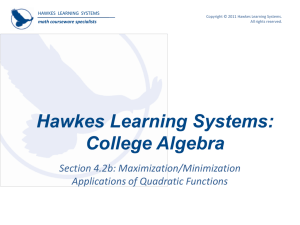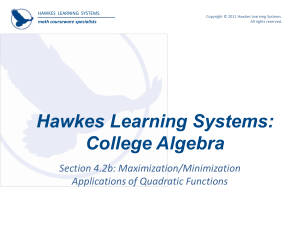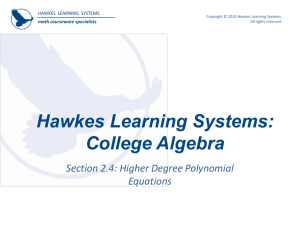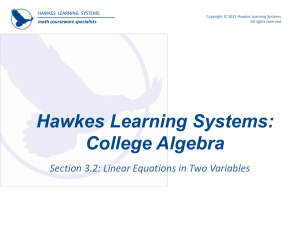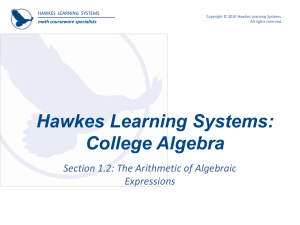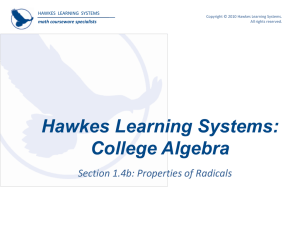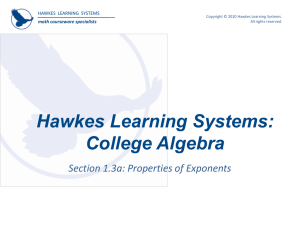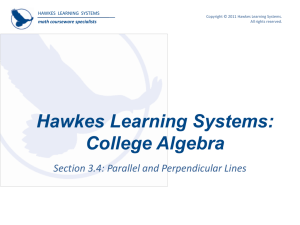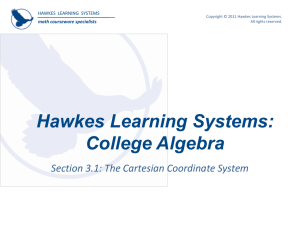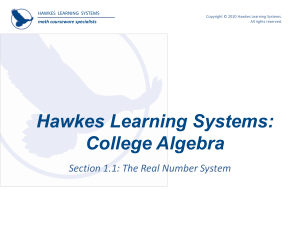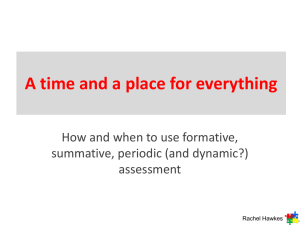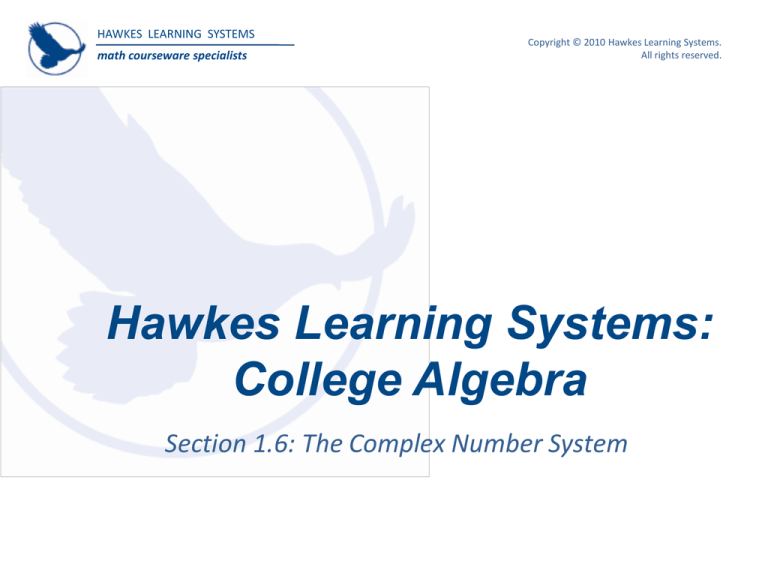
HAWKES LEARNING SYSTEMS
math courseware specialists
Copyright © 2010 Hawkes Learning Systems.
All rights reserved.
Hawkes Learning Systems:
College Algebra
Section 1.6: The Complex Number System
HAWKES LEARNING SYSTEMS
Copyright © 2010 Hawkes Learning Systems.
All rights reserved.
math courseware specialists
Objectives
o The imaginary unit i and its properties.
o The algebra of complex numbers.
o Roots and complex numbers.
HAWKES LEARNING SYSTEMS
math courseware specialists
Copyright © 2010 Hawkes Learning Systems.
All rights reserved.
The Imaginary Unit i and its Properties
Consider the following question:
For a given non-zero real number a, how many solutions
does the equation x 2 a have?
As we have noted before, this equation has two solutions:
x a and x a if a is positive. However, if a is
negative, it has no (real) solutions . The following
definitions of complex numbers explain this situation in
more detail.
HAWKES LEARNING SYSTEMS
Copyright © 2010 Hawkes Learning Systems.
All rights reserved.
math courseware specialists
The Imaginary Unit i and its Properties
The Imaginary Unit i
The imaginary unit i is defined as i 1. In other
words, i has the property that its square is 1: i 2 1 .
Square Roots of Negative Numbers
If a is a positive real number, a i a . Note that by
this definition, and by a logical extension of
2
2
2
exponentiation, i a i
a a.
HAWKES LEARNING SYSTEMS
math courseware specialists
Copyright © 2010 Hawkes Learning Systems.
All rights reserved.
Example 1:The Imaginary Unit i and its
Properties
Write the following radicals in simplified form in terms of i.
a. 9 i 9 3i
We write a constant, such as 3, before letters in
algebraic expressions, even if the letter is not a
2
variable. Remember: i is NOT a variable:i 1 .
b. 18 i 18 3i 2
We write the radical factor last.
HAWKES LEARNING SYSTEMS
Copyright © 2010 Hawkes Learning Systems.
All rights reserved.
math courseware specialists
Example 2: The Imaginary Unit i and its Properties
Write the following expressions in simplified form.
c. i 5 i 2 i 2 i 1 1 i i
6
2
2
2
i
i
i
i
d.
1 1 1 1
4
2
2
i
1
i
i
i
i
1
e.
4
4
4
HAWKES LEARNING SYSTEMS
math courseware specialists
Copyright © 2010 Hawkes Learning Systems.
All rights reserved.
The Imaginary Unit i and its Properties
Complex Numbers
For any two real numbers a and b, the sum a bi is a
complex number. The collection
a bi | a and b are both real
is called the set of complex numbers.
Ex: The number 2 3i is a complex number,
where a = 2 and b = –3.
HAWKES LEARNING SYSTEMS
math courseware specialists
Copyright © 2010 Hawkes Learning Systems.
All rights reserved.
The Imaginary Unit i and its Properties
Complex Numbers
The number a is called the real part of a bi , and the
number b is called the imaginary part. If the imaginary
part of a given complex number is 0, the number is
simply a real number.
Ex. 4 0 i 4 (4 is a real number)
If the real part of a given complex number is 0, the
number is a pure imaginary number.
Ex. 0 7 i 7i (7i is a pure imaginary number)
HAWKES LEARNING SYSTEMS
Copyright © 2010 Hawkes Learning Systems.
All rights reserved.
math courseware specialists
The Algebra of Complex Numbers
Some notes about Complex Numbers:
Every real number is a complex number with 0 as the
imaginary part. Furthermore, the set of real numbers is
a subset of the complex numbers.
Real Numbers ( )
Complex
Numbers
( )
Rational Numbers ( )
Integers ( )
Whole Numbers
Natural Numbers ( )
Irrational
Numbers
The field properties (closure, commutate, associative, distributive and the existence
of an identity and inverse), discussed in Section 1.2, still apply to complex numbers.
HAWKES LEARNING SYSTEMS
math courseware specialists
Copyright © 2010 Hawkes Learning Systems.
All rights reserved.
The Algebra of Complex Numbers
When faced with a complex number, the goal is to
write it in the form a bi .
Simplifying Complex Expressions
Step 1: Add, subtract, or multiply the complex
numbers, as required, by treating every complex
number a bi as a polynomial expression. Remember,
though, that i is not actually a variable. Treating a bi
as a binomial in i is just a handy device.
Step 2: Complete the simplification by using the fact
that i 2 1.
HAWKES LEARNING SYSTEMS
math courseware specialists
Copyright © 2010 Hawkes Learning Systems.
All rights reserved.
Example 3: The Algebra of Complex Numbers
Simplify the following complex number expression.
a. 6 2i 3 5i
6 3 5i 2i
3 7i
b. 1 4i 2 4i
1 2 4i 4i
1 0i
1
Treating the two complex numbers as
polynomials, we combine the real and
then the imaginary parts and simplify.
HAWKES LEARNING SYSTEMS
math courseware specialists
Copyright © 2010 Hawkes Learning Systems.
All rights reserved.
Example 3: The Algebra of Complex Numbers
Simplify the following complex number expressions.
2 i 1 2i
2 i 4i 2i 2
2 1 4 i 2 1
2 3i 2
4 3i
The product of two complex numbers leads
to four products via the distributive
property.
HAWKES LEARNING SYSTEMS
math courseware specialists
Copyright © 2010 Hawkes Learning Systems.
All rights reserved.
Example 4: The Algebra of Complex Numbers
Simplify the following complex number expression.
3 2i
2
3 2i 3 2i
9 6i 6i 4i 2
9 6 6 i 4 1
5 12 i
5 12i
Squaring a complex number leads to four
products via the distributive property.
HAWKES LEARNING SYSTEMS
math courseware specialists
Copyright © 2010 Hawkes Learning Systems.
All rights reserved.
The Algebra of Complex Numbers
Division of Complex Numbers:
In order to rewrite a quotient in the standard form a bi,
we make use of the following observation:
2
2 2
2
2
a
bi
a
bi
a
abi
abi
b
i
a
b
Given any complex number a bi , the complex number
a bi is called its complex conjugate.
We simplify the quotient of two complex numbers by
multiplying the numerator and denominator of the
fraction by the complex conjugate of the denominator.
HAWKES LEARNING SYSTEMS
math courseware specialists
Copyright © 2010 Hawkes Learning Systems.
All rights reserved.
Example 4: The Algebra of Complex Numbers
Simplify the quotient.
Find the complex conjugate of the denominator and
1 2i 2 3i
a.
multiply that by both the numerator and the
2 3i 2 3i
denominator.
2
2
2
a
bi
a
bi
a
b
Remember
that
, which
2 3i 4i 6i
makes solving the product in the denominator
49
much easier than using the distributive property.
2 7i 6
49
This would be an acceptable answer however, we
4 7i
have stated that all simplified complex numbers
13
should be in the form a bi .
4 7
i
13 13
HAWKES LEARNING SYSTEMS
Copyright © 2010 Hawkes Learning Systems.
All rights reserved.
math courseware specialists
Example 5: The Algebra of Complex Numbers
Simplify the quotients.
a. 2 i
1
1 2i
2i 2i
2i
4 1
2i
5
2 1
i
5 5
Find the complex
conjugate of the
denominator.
1 i
b.
i i
i
2
i
i
1
i
HAWKES LEARNING SYSTEMS
Copyright © 2010 Hawkes Learning Systems.
All rights reserved.
math courseware specialists
Roots and Complex Numbers
We earlier said that if a and b are real numbers, then
a
a
a b ab and
. If a and b are not real
b
b
numbers, then these properties do not necessarily hold. For
instance:
9 4
9 4
3i 2i
36
6
6i 2
6
In order to apply either of these two properties, first simplify any
square roots of negative numbers by rewriting them as pure
imaginary numbers.
HAWKES LEARNING SYSTEMS
Copyright © 2010 Hawkes Learning Systems.
All rights reserved.
math courseware specialists
Example 6: Roots and Complex Numbers
Simplify the following expressions.
2
a. 3 2
b. 9
9
3 2 3 2
3
3i
9 6 2 2
2
1
2
9 6i 2 i 2
i
9 6i 2 2
7 6i 2
i

